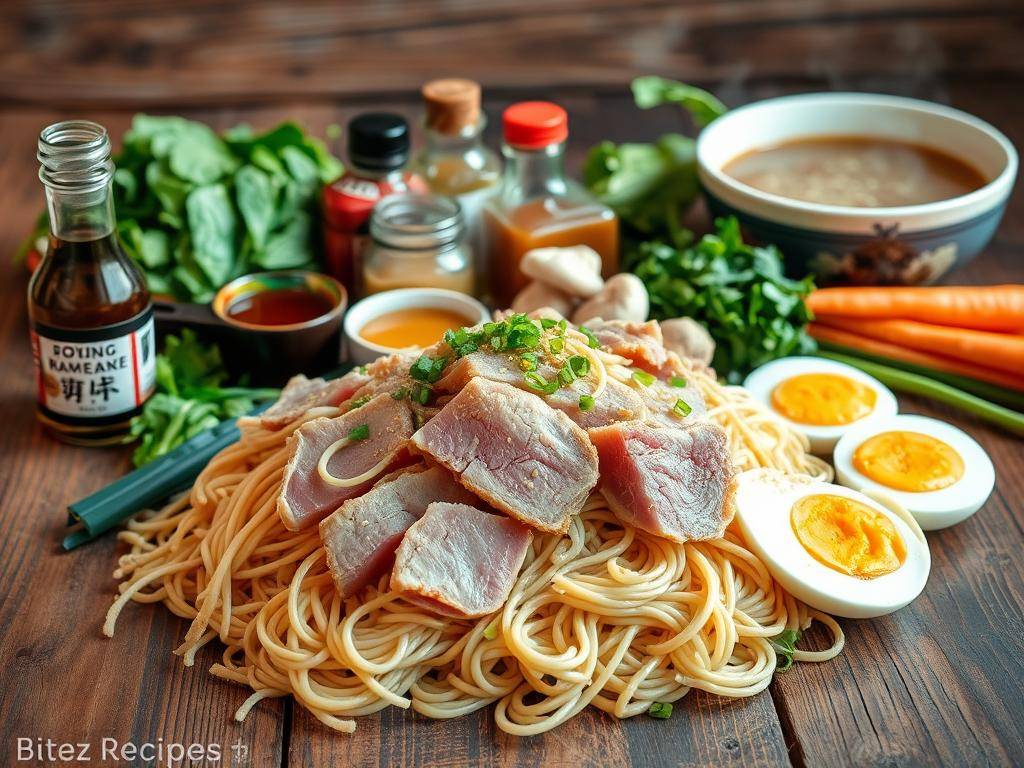It is simple to make homemade ramen recipes. You don’t require a gourmet kitchen or much experience. This simple ramen recipe requires plain ingredients to prepare a mouth-watering bowl of noodles and broth. You can top it with your own favorite ingredients to make it even better.

Bitez Recipes – Colorful still life of homemade ramen ingredients on a distressed wooden board. In the foreground, a stack of fresh ramen noodles, sliced pork, and soft-boiled eggs. In the center, a collection of condiments such as soy sauce, sesame oil, and scallions. In the background, a steaming bowl of broth and a selection of vegetables such as spinach, mushrooms, and carrots. Warm, natural light bathes the scene in a cozy glow, highlighting the rich colors and textures of these wholesome, homemade ramen staples.
Make your own ramen at home. You can have rich tonkotsu broth or light shoyu. This guide simplifies it, even with minimal kitchen equipment. You’ll have wonderful flavor without the fuss.
Key Takeaways
- Step-by-step instructions make ramen accessible for all skill levels.
- Personalizable ingredients allow you to pair dietary requirements and preferences.
- No special equipment required—usual kitchen tools do the trick.
- Time-saving tips minimize prep without compromising rich broth flavors.
- Discover how to balance classic components with contemporary shortcuts.
What Makes Homemade Ramen So Special?
Having a bowl of yummy homemade ramen is really enchanting. It’s not instant noodles or takeout. You can select each ingredient because you’re making it yourself.
The aroma of the broth will turn your kitchen into a warm Japanese spot. Each slice, from long-cooked bones to crisp vegetables, contributes something special. Pre-cooked versions can’t do that.
Preparing ramen is time-consuming. Boiling pork bones for hours produces a rich broth. This is difficult to achieve with quick solutions.
Having fresh ingredients such as noodles and pork allows you to have control over the flavor. You can add spinach for a vegetarian version or substitute soy sauce with miso. This way, you can prepare each bowl to your liking.
Homemade Japanese ramen is a balance of tradition and innovation. It’s how you pay respect to Japanese cuisine while experimenting with new flavors. Putting toppings such as pickled ginger or soft-boiled eggs makes it more remarkable.
It’s a treat with each bite that rewards hard work and flavor. The pleasure of consuming something made by your hands makes it special.
The History and Evolution of Ramen
The story of Ramen’s evolution from humble street fare to global popularity is intriguing. It is one of how it turned into a cultural phenomenon. It bridges its history to your homemade japanese ramen today.
Ramen originated in China and came to Japan in the late 1800s. It became a speedy and delicious food during post-war lean times. These humble beginnings laid the ground for the traditional ramen recipe we cherish today.
Regional Styles Shaped by Geography
Japan’s regions created ramen their own:
| Region | Broth Type | Signature Flavors |
|---|---|---|
| Hokkaido | Miso | Rich, hearty with sweet miso base |
| Hakata | Tonkotsu | Cloudy pork bone broth |
| Tokyo | Shoyu | Clear soy sauce-based broth |
Rise in America: From Instant to Gourmet
America was hooked on instant ramen in the 1970s. Today, authentic ramen noodle soup shops are ubiquitous. Chefs blend Japanese tradition with domestic flavors, so you can make delicious homemade japanese ramen that’s as good as Tokyo’s.
Understanding ramen history makes you a wiser bowl-maker at home. It’s not only about the food. It’s a story of transformation and culture exchange.
Essential Ingredients for Authentic Homemade Ramen Recipe
Learning to prepare homemade ramen recipe starts with the selection of quality ingredients. Each component, including the broth and the toppings, contributes to the heart of the dish. The following is a guide to making authentic ramen broth and traditional ramen recipe at home.
According to professional chefs, a good ramen bowl starts with fresh ingredients.
Proteins: Pork bones, chicken backs, or dried kombu can be used for the broth. Bones becoming rich in slow-cooking prepares the broth rich. For genuine ramen broth, bones are cooked 8–12 hours to achieve deep flavor.
- Aromatics: Ginger, minced garlic, and scallions provide flavor. Charcoal-grilled garlic produces a smoky flavor in conventional ramen recipe.
- Tare Base: Select soy sauce (shoyu), miso paste, or salt for the flavor of the broth. Use small quantities at the beginning to balance.
Adding fat such as toasted sesame oil or pork fat that has been rendered makes it creamy. Use vegetable oils less for the optimal authentic ramen broth texture. Vegetarians may substitute with toasted sesame oil and konbu dashi.
- Noodles: Select firm, wheat-based noodles. Fresh noodles are springy; dried ones will do if fresh is not available.
- Toppings: Braised chashu pork, marinated ajitama eggs, and preserved menma bamboo shoots provide classic flavors. Add nori sheets and green onions for freshness.
For specialty items such as kombu or kelp, try specialty Asian markets or brands similar to Marukome miso. Even minor adjustments keep your bowl authentic. Pay attention to quality proteins and fresh aromatics to enhance any homemade ramen recipe.
Kitchen Equipment You’ll Need for Perfect Ramen
Creating an amazing bowl of ramen begins with the proper equipment. New or seasoned, the proper equipment makes a huge difference. Let’s examine what you’ll need for an easy ramen recipe at home to be successful.

A tidily composed still life with necessary kitchen equipment to prepare ramen in home. In the near ground, a wooden cutting board with a sharp Japanese knife, a pair of chopsticks, and a bamboo ladle. In the middle ground, a cooking pot of homemade broth with steam ascending, set in a bouquet of fresh ramen noodles, half soft-boiled eggs, and sliced scallions. In the background, a Bitez Recipes brand bamboo steamer, a jar of soy sauce, and a bottle of sesame oil, all under warm, natural light. The overall atmosphere is one of cooking intensity and home comfort.
Basic Tools for Beginners
Start with these essentials in most kitchens:
- Large stockpot (6+ quarts) for simmering broth
- Fine-mesh strainer for clear broth
- Ladle and tongs for assembly
- Chef’s knife and cutting board
These essentials make it easy to prepare a quick ramen recipe. A heavy pot avoids scorching. A strainer keeps the broth clear.
Advanced Equipment for Ramen Enthuasiasts
For more, get:
- Pressure cooker (e.g., Instant Pot) to reduce broth time by 50%
- Immersion circulator for sous-vide chashu pork
- Traditional ramen bowls to keep broth warm
A pressure cooker reduces broth time from hours to minutes, a Tokyo ramen expert tip.
Substitutions for Specialized Equipment
No pressure cooker? Simmer broth uncovered in your stockpot for 2–3 hours instead. Use a colander as a noodle basket or mold eggs in mason jars for homemade chashu. Even a regular saucepan will do for a simple ramen recipe. Quality ingredients are important. Be creative with what you have!
Creating the Perfect Ramen Broth from Scratch
The key to producing fantastic homemade japanese ramen is mastering broth. If you wish for rich tonkotsu or rich shoyu, technique is your priority. With these steps, your broth will be the best homemade ramen broth ever.
Tonkotsu (Pork Bone) Broth
Simmer pork bones 12+ hours to achieve creamy broth. To start, blanch the bones to clean them. Next, simmer carefully not to scum.
Add ginger, garlic, and kombu for added flavor. This maintains the pork’s flavor in the foreground.
Shoyu Broth
Begin with dashi (kombu and katsuobushi) and chicken bones to make a light broth. Add Marukome soy sauce for saltiness, but without excess. This ensures other flavors remain unclouded.
Boil 3-4 hours. This mixes flavors to make a savory broth.
Miso Broth
Add sweetness with white miso and saltiness with red miso. Combine them to achieve balanced flavor. Add miso towards the end to preserve probiotics.
Add mirin and sake for brightness. This keeps the authentic ramen broth balanced.
Ramen Recipe Vegetarian & Vegan Options
For vegetable broths, caramelize mushrooms and onions. Then, simmer with konbu and shiitake dashi. Coconut milk can be used to make it creamy, such as tonkotsu.
Roasted soy sauce and nutritional yeast provide depth. This creates a rich, filling broth.
Time-Savingers for Busy Cooks
- Pressure cook tonkotsu broth in 3 hours of high pressure
- Freeze broth in ice cube trays for easy portioning
- Employ store-bought dashi stock as a foundation for shoyu or vegan broths
Quality wins even with short cuts. Employ fresh bones or high-quality dried mushrooms. This prevents flat flavors.
Homemade Ramen Noodles vs Store Bought
Preparation of homemade ramen noodles is time-consuming. You combine high-gluten flour and kansui for the yellow hue. The chewy texture is well worth it. Rolling out and drying the dough takes 2–3 hours, perfect for weekend cooks.
Hasty cooks can skip time with great store-bought choices. They don’t sacrifice flavor.
- Homemade: Requires stand mixer or hand-cranked pasta machine. Let dough rest 30 minutes to cut.
- Store-Bought: Select fresh refrigerated noodles (e.g., Marukome or Sun Noodle) as bases for ramen noodle soup. Dry noodles are suitable for broths with intense flavorings.
- Hybrid Approach: Substitute instant noodles as a base with homemade broth for a convenient solution.
Good dried noodles such as Ajinomoto’s Maruchan Premium possess realistic texture. But lack the bounce of fresh noodles. Fresh noodles become limp if overcooked. Therefore, add them towards the end when preparing ramen noodle soup.
Select homemade for holidays. Select store-bought when time is limited. Either option, the correct noodles with a hearty broth create each bowl rewarding.
Best Homemade Ramen Recipe: Step-by-Step Instructions
Learn how to prepare the best ramen recipe with this simple guide. Start with the preparation of ingredients such as fresh chashu pork, scallions, and soft-boiled eggs. Prepare your tools and group your ingredients to make preparation easier. This is crucial even for the most basic ramen recipe.
Proceed with these steps to prepare bowls of ramen that are similar to restaurant-quality ones.
Preparing Your Ingredients
Begin by washing and cutting vegetables such as bamboo shoots and nori. Marinate scallions in soy sauce for 10 minutes to season. If using fresh noodles, cut them in advance. This will keep your easy ramen recipe on track.
Broth Development Timeline
Simmer mushrooms or bones for 2-4 hours. Use a timer. To cut a quick ramen recipe, reduce the simmer time by 30% using concentrated stocks. Skim the foam every 30 minutes to clarify the broth. Reserve broth for reuse.
Cooking and Seasoning Techniques
Simmer noodles 1-2 minutes, then chill them in ice water. Season broth with soy sauce, mirin, and fish sauce. Don’t overdo the salt. Allow flavors to combine before serving.
Assembly and Presentation Tips
- Begin with broth, followed by noodles to absorb flavors.
- Place toppings in sequence: proteins, vegetables, eggs, and garnishes.
- Serve in deep bowls to prevent spills. Add sesame seeds for a nice touch.
Take the following steps to create a ramen bowl that’s warm and textured. Timing is everything in avoiding overcooking noodles. Your best ramen recipe is complete—present it with assurance and appreciate the homemade goodness.
Creative Homemade Ramen Toppings and Variations

Close-up of a beautifully arranged assortment of fresh, homemade ramen garnishes on a wood surface, shot in soft natural light. Foregrounded are various colorful sliced vegetables like carrots, scallions, and red peppers in combination with soft-boiled ramen eggs, crispy fried onions, and shredded nori. Middle ground includes marinated mushrooms, delicate braised pork belly, and seasoned bamboo shoots for added depth and texture. The background is a few uncooked, whole ramen noodles, foreshadowing the delectable dish to be produced. The general atmosphere is fresh, homemade bounty, encouraging the viewer to visualize the tasty possibilities of a Bitez Recipes homemade ramen dish.
After your broth starts simmering and noodles are cooking, you may add toppings for your ramen to be special. Experiment with toppings so that your easy ramen recipe at home remains interesting. By doing this, you can savor delicious homemade ramen every day.
Traditional Japanese Toppings
Start with chashu (braised pork belly) or ajitama (sulfur-marinated eggs). Cut the pork into thin strips or shell the eggs to make the yolks visible. Mix in nori sheets and menma (bamboo shoots, fermented) to give it that added taste. These are essentials of an incredible bowl.
Fusion-Inspired Toppings
- Crispy tofu or shiitake mushrooms for vegan crunch
- Fried garlic chips for umami depth
- Pickled jalapeños or corn kernels for spicy or sweet surprise
- Caramelized onions or crispy bacon for dense textures
Seasonal Ingredient Suggestions
Switch up your toppings with the seasons:
- Spring: Pea shoots, asparagus, or radish sprouts
- Summer: Fresh corn, cherry tomatoes, or cucumber slices
- Fall: Roasted mushrooms, kabocha squash, or pumpkin
- Winter: Bok choy, spinach, or citrus zest
Customizing for Dietary Preferences
Make your ramen work for any diet:
- Vegan: Incorporate seitan, tofu, or mushroom proteins
- Gluten-free: Opt for quinoa or buckwheat noodles
- Low-sodium: Reduce broth salt and include fresh herbs such as basil or cilantro
Get creative with your ramen. Add kimchi with poached eggs or crispy rice crumbs. Each selection makes your homemade ramen toppings special and one of a kind.
Conclusion: Mastering Your Homemade Ramen Journey
Homemade ramen recipe success is derived from understanding its most important components: rich broth, springy noodles, and assertive toppings. You can begin with basic steps such as employing store-bought noodles and a simple broth. Then you can improve with time.
The best ramen recipe is one that is suited for your kitchen. You don’t need to know it all at first. Begin in a simple manner and introduce complexity along the way.
Batch cooking broth at the weekend is a brilliant idea. It allows you to freeze portions for a speedy delicious meal later. Have a notebook to record your go-to seasoning ratios and topping pairings.
Be respectful of ramen’s cultural origins, learn from Japanese etiquette, but also don’t be shy to put your own spin with regional ingredients such as spicy mayo or truffle oil. Experiment until you get the balance of salt, umami, and texture that you like.
Ramen is not just a meal; it’s an artistic process. Begin with a recipe, then modify ingredients to suit your taste or the time of year. Share your bowls or enjoy them privately—each bowl gets you closer to your ideal ramen.
Even professional chefs continue to refine their recipes. Take the journey and have fun. Your next ramen adventure awaits—what will your first bowl be?
Also Read Latest Recipe: “Bitter Gourd Karela Health Benefits”
FAQ
What is the best homemade ramen broth recipe?
The best homemade ramen broth recipe combines tonkotsu (pork bone) for richness. It adds shoyu (soy sauce) for depth or miso for flavor. Simmer the ingredients for several hours to achieve the best flavor.
How can I make homemade ramen noodles?
Combine high-gluten wheat flour, kansui (alkaline water), and water to form dough. Knead, rest, roll, and cut into noodles. Cooking your noodles from scratch improves your ramen!
What are some simple ramen toppings I can use?
Simple toppings are soft-boiled ajitama eggs and sliced chashu (braised pork belly). Add crunchy scallions, nori (seaweed), and menma (fermented bamboo shoots) as well. These toppings bring flavor and color.
Can I prepare a vegetarian or vegan ramen broth?
Yes! Utilize kombu (seaweed) and dried shiitake mushrooms as a starting point. Add roasted vegetables for depth of flavor without using animal products.
What is different about homemade ramen compared to instant ramen?
Homemade ramen tastes deeper and more authentic. Preparing your own broth and noodles allows you to customize and eat a fresher meal.
How do I get the ideal ramen broth clarity?
Blanch bones initially to decontaminate. Skim off foam and filter with a fine mesh for transparent broth.
What can I do if my ramen noodles are too cooked?
Cook the noodles individually and add to broth at the time of serving. This allows you to manage cooking time for the desired texture.
How can I make my ramen suit dietary needs?
Use gluten-free noodles for a gluten-free version. Experiment with plant-based proteins for a vegetarian or vegan version. Modify seasoning for reduced-sodium meals. Ramen is excellent for dietary modifications!








